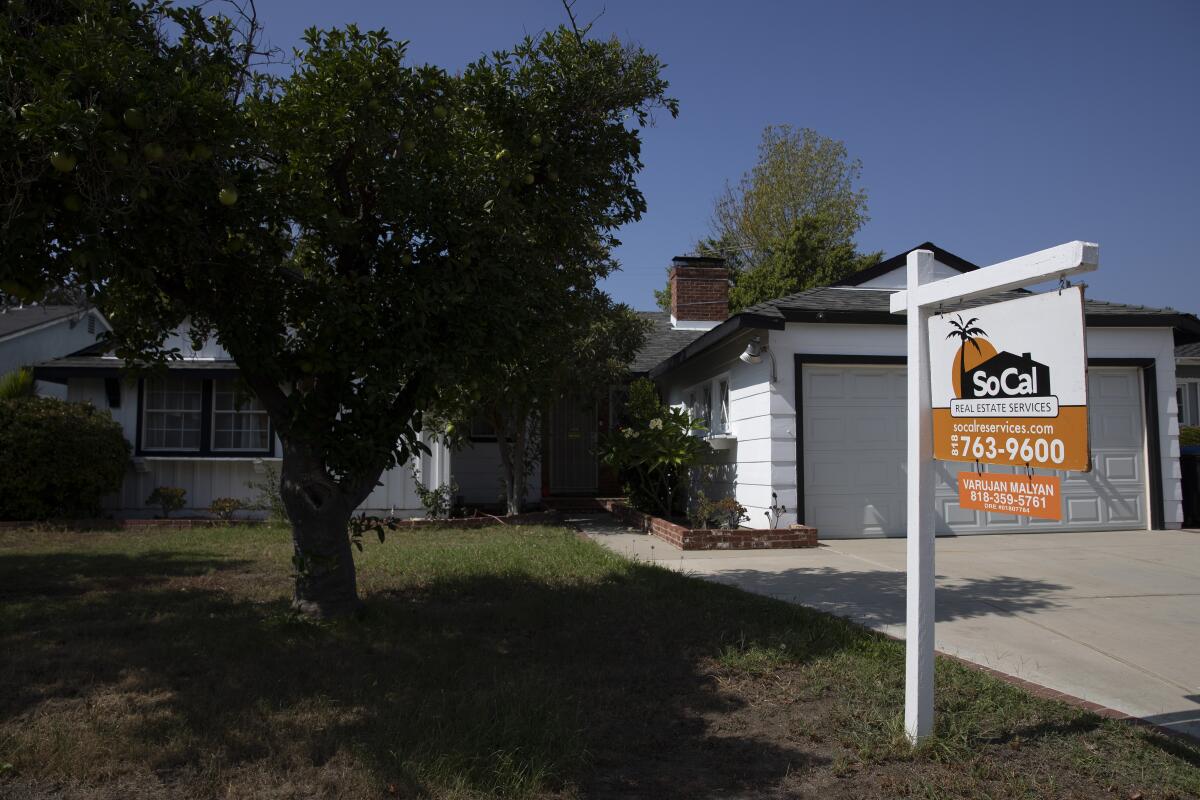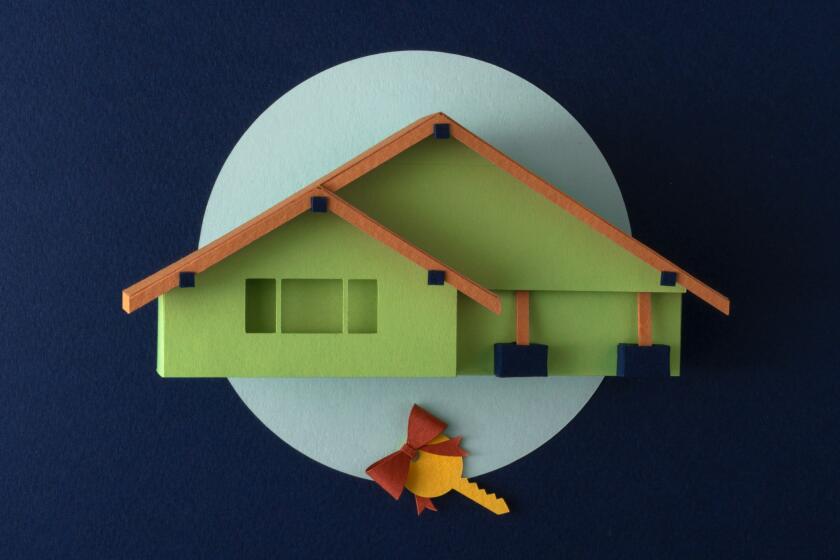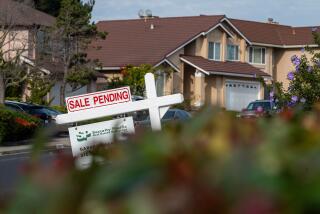Looking to buy a home this spring? Good luck, there’s not much out there

- Share via
Over the last few months, Larry Chanes and his wife, Claudia, debated selling their Upland home and moving an hour away to Murrieta. The couple, with two daughters at home, wanted more space and to be closer to work and family.
But when they ran the numbers, the Chaneses decided against listing their home and making the move to southern Riverside County.
They’d have no choice but to swap out their 2.75% mortgage for one in the 6% range, and the new rate would make the monthly payment difficult. Even if they could comfortably afford it, that much money going just to interest felt like a waste.
“We are basically throwing money away” at 6%, said Chanes, a 47-year-old operations manager for a water utility. He noted that though they’d like more space, his family lives in a 2,500-square-foot house with a pool. “I don’t need to move.”
In Southern California, and housing markets across the country, normal seasonal trends are askew.
At a time of year when the number of homes for sale usually climbs in anticipation of the prime spring buying months, it’s been on the decline, driven lower by people like Chanes who don’t want to ditch their rock-bottom mortgage rates or sell into a market where home prices have been falling.
That “seller strike” — a problem since rates jumped last year — is making it tougher for others to become homeowners.
Not only has the lack of inventory kept home prices from dropping more than they otherwise would have when rates surged to 7% last year, but seller hesitancy has become so bad that some experts think prices may stop declining.
While potential sellers hold firm, buyers — some of whom would be first-time homeowners and don’t need to sell — have been more willing to follow traditional patterns and return after the winter holidays.
Real estate agents and other experts say the hunt for slightly better deals relative to the last several months is a major reason.
A no-BS guide to buying your first home in Southern California.
Although home prices haven’t tanked, they are lower than last year, and mortgage interest rates have fallen from the recent peak into the 6% range, creating an uptick in demand — again, relative to the last several months — at a time when few new listings are hitting the market.
“If you have 10,000 houses on the market in Southern California, you have to be affordable for 10,000 buyers,” said Michael Simonsen, founder of Altos Research, who said weekly March data indicate local prices may have resumed their climb. “If there is only 1,000 houses on the market, you don’t have to be affordable to the median income; you only have to be affordable to 1,000 families.”
Whether prices stop falling isn’t clear.
The market is still far slower than this time last year, when rates were much lower and were just starting their rapid ascent. Though homes are selling faster and closer to asking price than a few months ago, that’s not uncommon because people don’t like to move around the holidays.
As of February, prices were down between 4% and 12% in L.A. County since the peak in pricing last year, according to a review of various platforms that track prices in different ways. And some experts think prices will decline a fair amount more, because homes are still unaffordable for too many households.
But citing seller hesitancy, Richard Green, director of the USC Lusk Center for Real Estate, said he doubts home prices have much more to fall, unless the current banking turmoil worsens and causes big increases in unemployment.
Green considers that scenario a distinct possibility, but for now overall job growth continues at a time many homeowners have a strong incentive not to sell.
According to mortgage data firm Black Knight, an estimated 13.4 million homes nationwide have first mortgages with rates below 3%, while 20.9 million have loans with rates from 3% to 3.99%. Together, that accounts for about 65% of all U.S. homes with a first-lien mortgage.
Only about 4% of homes have first mortgages with rates of 6% and above.
Andy Walden, vice president of enterprise research with Black Knight, said there hasn’t been this great of a difference between the rate people have on their current mortgage and the going market rate since probably the 1980s, another time of high inflation.
This has turned the usual seasonal trends upside down.
Typically, the number of listings bottoms out in January then rises between 5% to 15% by the end of March, according to Simonsen.
As of March 24, the number of listings across three major Southern California counties — Los Angeles, Orange and Riverside — was 15% lower than the start of the year, according to Altos Research data.
“Almost everybody refinanced in the last three years,” said Amber Dolle, a real estate agent with Keller Williams in Valencia. “Sellers aren’t selling unless they have to.”
Her client list is a prime example. She has three listings. One client is older and is downsizing; another is moving out state for tax reasons.
The third, Arlo and Zach Tysinger, moved to North Carolina after Arlo accepted a job as a pastor there. The couple and their two young kids are renting at the moment, but once their Santa Clarita home sells, they plan to buy, undeterred by high mortgage rates.
“Anything we buy in North Carolina is going to be significantly cheaper,” said Zach Tysinger, who was able to keep his L.A.-area sales job by working remotely.
As L.A.’s new “mansion tax” looms, realtors are giving away a free Bentley or Aston Martin with a home purchase before the April 1 deadline to avoid paying the tax.
Simonsen said some listing relief could be on the horizon.
In recent weeks, inventory levels have been relativity flat and he thinks the normal seasonal factors — people like to move before their kids restart school — should eventually get more traction and the number of listings will starting rising again. But he cautioned things won’t be easy and the market could remain tight for years.
“People who have their mortgages locked in [at under 3%,] they in general will choose to hold on to those homes much longer than we have ever in the past,” he said. “It’s such an amazingly good deal.”
Few, if any, experts expect mortgage rates to fall below 3% anytime soon or maybe ever again.
But USC’s Green said rates don’t need to drop that far for the market to loosen up. The gap just needs to narrow.
He estimated rates in the 4% range would do the trick, but even that moment could be a ways off.
The Mortgage Bankers Assn., a national trade group, expects average rates to fall to 6.1% in the second quarter of this year and to 5.3% by years end. It’s not until the third quarter of 2024, that the trade group predicts rates will be below 5%.
In the meantime, real estate agents are trying to lure more sellers into the market.
In late February, Rodeo Realty agent Tregg Rustad sent out an email blast, detailing nine recent L.A.-area listings that had a combined 76 offers and ultimately sold “at or even well over the list price.”
He pitched the current moment as an opportunity for sellers — one in which they could “leverage demand we haven’t seen since last summer.”
More to Read
Sign up for Essential California
The most important California stories and recommendations in your inbox every morning.
You may occasionally receive promotional content from the Los Angeles Times.












